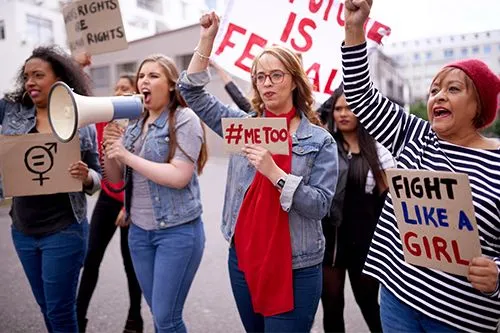The Transformative Power of Social Justice Movements: Shaping a More Equitable Future
Social justice movements have long been catalysts for change, driven by the pursuit of equality and fairness across all aspects of society. These movements unite diverse voices and challenge oppressive systems, working towards a future where everyone has access to the same rights, opportunities, and resources. From historical struggles to today’s digital activism, social justice movements continue to spark profound transformations around the world.
A Historical Perspective on Social Justice Movements:
The history of social justice movements is rich with stories of resilience and defiance against deeply ingrained injustices. One of the earliest and most impactful movements was the fight to abolish slavery in the 19th century. Spearheaded by courageous individuals who believed in the dignity of all people, the abolitionist movement challenged the very foundations of societal and economic structures, eventually leading to emancipation in many parts of the world.
Fast forward to the mid-20th century, and the civil rights movement took center stage, especially in the United States. Icons like Martin Luther King Jr., Malcolm X, and countless unnamed activists fought to dismantle segregation, gain voting rights, and challenge institutionalized racism. Their efforts resonated globally, inspiring similar movements across various nations, and laid the groundwork for future battles for racial justice.
Parallel to this was the feminist movement, which has evolved through multiple phases to address gender disparities. Starting with the fight for women’s suffrage, it expanded to include reproductive rights, workplace equality, and combating gender-based violence. Today, feminist movements are interwoven with other social justice causes, emphasizing intersectionality and the importance of inclusivity.
Social Justice in the Digital Age:
In the current era, social justice has taken on new dimensions with the rise of digital platforms and social media. Movements such as #BlackLivesMatter and #MeToo have shown how quickly a cause can gain global momentum with the help of online communities. These movements, born out of modern-day crises of racial injustice and gender-based violence, have inspired millions to participate in protests, share stories, and demand accountability from institutions and individuals alike.
#BlackLivesMatter, for instance, began as a response to police violence against Black individuals, but it has grown into a global movement addressing the systemic racism present in various sectors, including healthcare, education, and the criminal justice system. Similarly, #MeToo ignited a powerful conversation about sexual harassment and abuse, amplifying the voices of survivors and leading to tangible changes in workplace policies and cultural attitudes.

The Rise of Intersectional Activism:
Today’s social justice movements embrace a more holistic approach, recognizing that issues of inequality are interconnected. Intersectionality—a concept developed by Kimberlé Crenshaw—explains how various forms of discrimination overlap, affecting individuals in different ways based on their race, gender, class, sexuality, and other factors. As movements become more intersectional, they are able to address complex issues in a more inclusive manner.
For example, Indigenous communities not only fight for land rights but also for environmental justice, highlighting the disproportionate impacts of environmental degradation on marginalized groups. In recognizing these overlapping struggles, social justice movements today are breaking down silos and creating broader coalitions to advocate for comprehensive change.
Allies can be powerful amplifiers of marginalized voices, using their platforms to raise awareness and drive action. Whether it’s attending protests, lobbying for policy changes, or engaging in difficult conversations within their communities, allies play a crucial role in pushing the movement forward. However, meaningful allyship demands consistent commitment and self-reflection to avoid perpetuating the same systems of privilege that movements seek to dismantle.
The Future of Social Justice Movements:
As we look to the future, social justice movements are poised to continue evolving in response to both new and ongoing challenges. Climate justice, for example, is emerging as a critical intersectional issue that ties together environmental sustainability with the fight for racial, economic, and gender equity. Movements that focus on equitable access to healthcare, education, and economic resources will also remain key as inequality continues to grow in many parts of the world.
Grassroots activism will likely remain at the core of these efforts, with new generations of leaders bringing innovative strategies and ideas to the table. Technology will continue to play a pivotal role in organizing and mobilization, making it easier to build global networks and hold power to account.
Ultimately, the strength of social justice movements lies in their ability to adapt, grow, and maintain momentum in the face of adversity. The challenges ahead are complex, but these movements demonstrate the profound impact collective action can have in reshaping societies toward a more just and equitable future for all.
As the journey toward justice continues, social justice movements offer a blueprint for creating real, lasting change. They remind us that by uniting across differences and standing up for those who are most marginalized, we can build a world where equity and human dignity are not aspirations but reality.
FAQs:
1. What defines a social justice movement?
Social justice movements are collective efforts aimed at addressing and dismantling systemic inequalities and injustices within society. They seek to promote fairness and equal opportunities across various dimensions such as race, gender, sexuality, and socioeconomic status.
2. Can you provide examples of social justice movements?
Notable social justice movements include the civil rights movement, feminist activism, LGBTQ+ advocacy, #BlackLivesMatter, #MeToo, environmental justice efforts, and campaigns for Indigenous rights. Each focuses on distinct issues but shares a common goal of advancing equity and justice.
3. Why is the concept of intersectionality crucial?
Intersectionality, a term introduced by Kimberlé Crenshaw, is vital because it recognizes that different forms of discrimination—like racism, sexism, and classism—intersect and compound. This perspective ensures that social justice efforts are inclusive and address the multifaceted nature of oppression.
4. How do social justice movements effect change?
These movements drive change through a mix of grassroots activism, public demonstrations, educational campaigns, policy advocacy, and legal challenges. By raising awareness and mobilizing communities, they push for reforms and shifts in societal attitudes.
5. What is the role of allies in these movements?
Allies are individuals who support social justice causes despite not being directly affected. They contribute by amplifying marginalized voices, advocating for change, and leveraging their own privilege to challenge systemic injustices. Effective allyship involves continuous learning and active participation.
6. How has digital technology influenced social justice movements?
Digital technology, especially social media, has transformed social justice activism by enabling rapid information sharing, global outreach, and coordinated action. Platforms like Twitter and Instagram have played a crucial role in movements such as #BlackLivesMatter and #MeToo.
7. What does the future hold for social justice movements?
Looking ahead, social justice movements are expected to focus on integrating issues like climate justice with racial and economic equity. Technological advancements will continue to shape organizing strategies, while global collaboration will be key to addressing complex challenges.
8. What obstacles do social justice movements encounter?
Social justice movements face several challenges, including resistance from powerful institutions, media misrepresentation, and entrenched systemic barriers. Internal disagreements and the risk of burnout among activists also pose significant hurdles.
9. Can individual actions impact social justice?
Yes, individuals can make a significant difference by engaging in activism, supporting policy changes, educating themselves and others, and practicing solidarity.
10. How important is policy reform in advancing social justice?
Policy reform is crucial for achieving lasting change, as it addresses the root causes of inequality. Social justice movements often focus on advocating for legal changes in areas such as civil rights, labor laws, environmental protections, and healthcare to create systemic improvements.




